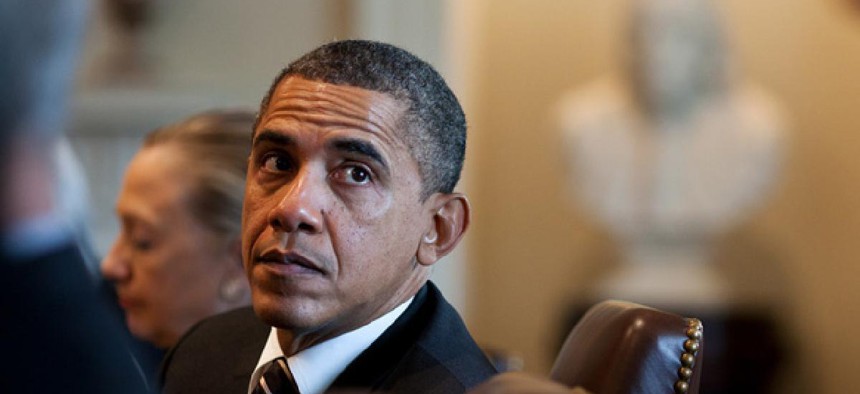
Pete Souza/White House
Election Could Come Down to the Wire
Don’t put much stock in predictions that President Obama will coast to victory.
Presidential elections have a lot of moving parts. They rarely turn on any single factor or issue. Take, for example, the tensions over Tehran’s nuclear aspirations and the possibility of an attack on Iranian nuclear facilities by either Israel or the United States. In five minutes, the tone and direction of this election could completely change. But of the “known unknowables,” as former Defense Secretary Donald Rumsfeld might say, the big one is what happens with the economy between now and Nov. 6.
Recent polls have shown President Obama putting some daylight between himself and presumptive Republican nominee Mitt Romney. The president’s advantage has ranged from 4 points, 49 percent to 45 percent, nationwide in a March 25-26 Gallup/USA Today poll, to as much as 11 points in a March 24-25 CNN/Opinion Research survey, 54 percent to 43 percent. Most recently, an ABC News/Washington Post poll conducted April 5-8 splits the difference, with a 7-point spread, 51 percent to 44 percent.
A separate March 20-26 Gallup/USA Today poll of voters in 12 swing states put Obama’s lead at 9 points, 51 percent to 42 percent, compared with Romney’s narrow, statistically insignificant leads of 1 and 2 points in similar Gallup/USA Today polls earlier this year in the same dozen states.
The RealClearPolitics average of recent polls puts Obama’s advantage at 5.3 percentage points. The Huffington Post/Pollster.com trend estimate gives him a much narrower lead: just 1.6 percentage points.
When a president runs for reelection, his job-approval ratings are more significant than the trial heats. Voters who approve of the job a president is doing are very likely to vote to reelect him. Voters who disapprove are very likely to support the president’s opponent. Obama’s job ratings have ranged in recent weeks from as low as 44 percent to as high as 50 percent. The RealClearPolitics average and the Huffington Post/Pollster.com trend estimate show Obama’s approval rating at 48 percent and his disapproval score at 47 percent.
How quickly and effectively Romney makes the turn from the primary season to a campaign aimed at the general election’s swing voters is key. Obama has been running a general-election campaign all along. With Rick Santorum’s decision on Tuesday to suspend his campaign, Romney can accelerate his transition. Simply talking to, rather than past, independent and swing voters should gain him a few points.
Without a doubt, Romney and his party have much rehabilitation work to do. The Gallup swing-state survey indicates that among independent voters, he has dropped from an 8-point lead, 49 percent to 41 percent, in October and from a 7-point advantage, 46 percent to 39 percent, in December to a 9-point deficit, 48 percent to 39 percent, in the most recent poll.
Romney must quickly reverse directions, probably grinding some gears in the process, but Obama’s fate is less in his own hands than in the economy’s. As of now, foreign policy is a good news/bad news proposition. The good news for the president is that the public generally approves of his handling of foreign policy. Indeed, if judged on that performance alone, he would win the election quite comfortably today. The bad news for him is that foreign policy doesn’t seem to be a driver for many voters; their focus is the economy.
If economists’ consensus is correct, Democrats who hoped that an improving economy would boost the president’s reelection prospects might be disappointed; Obama’s detractors looking for a plunge to seal his fate may be disappointed as well. Certainly, the economy is better today than it was six months ago; gross domestic product growth is higher and unemployment is lower. Consequently, the president’s approval ratings have risen. But that trajectory might not continue. In the just-released, April 10 Blue Chip Economic Indicators survey of 56 top economists, the consensus of forecasts calls for tepid growth between now and the election: 2.2 percent GDP growth for the just-completed first quarter, 2.3 percent for the second quarter, 2.4 percent for the third quarter, and 2.6 percent in the final quarter of the year, The election, of course, falls in the middle of the fourth quarter. While better than the GDP growth of less than 2 percent in the first three quarters of 2011, the outlook is considerably below the 3 percent pace of last year’s fourth quarter.
For unemployment, this year’s second-quarter forecast is for 8.2 percent, the same as the reported jobless rate in March, dropping just one-tenth of a point in the third quarter to 8.1 percent and another tenth of a point to 8 percent in the fourth quarter. That’s better than the 9-plus percent unemployment in the first nine months of last year, but it’s not much of an improvement. (And, of course, some argue that the dropping jobless rate is more a product of people leaving the potential labor force than of real job creation.)
With these economic numbers, Obama is not close to putting this election away, as some people seem to think he has. The current Intrade odds give the president a 61 percent chance of reelection, but the economic numbers suggest a tightening race, fought down to the last couple of points and states.






